Business Offer In Compromise Financial Statement: IRS Form 433-B (OIC): The Complete Guide
Form 433-B (OIC) is used to determine the ability to pay a business on its IRS tax debts. The IRS is looking to determine if the business is solvent or if it is insolvent to determine the amount it would accept for a settlement. The IRS considers the solvency of the business owner also. Below you can see a video on filling the form out and below the video is the written guide.
Not For All Businesses
Only complete Form 433-B (OIC) for businesses that are a Corporation, LLC classified as a Corporation, Partnership, or Other LLC. Sole proprietorships and LLCs taxed as a sole proprietorship before 2009 should use IRS Form 433-A (OIC) guides Form 433-A (OIC).
Software Considerations and Recommendations
Fill out the form using Adobe Acrobat Reader or Adobe Acrobat Pro. You can download Adobe Acrobat Reader for free here. Do not fill out Form 433-B (OIC) in a browser or another application, it often does not come out properly or has saving issues. Make sure you can save the form before proceeding. Make sure you are connected to a working print and print a test page if you cannot save the forms. You do not want to spend all your time filling it out only for it not to print or save correctly.
Fill It Out the Best You Can
Form 433-B (OIC) should be completed as accurately as possible. When you come across areas you are not totally sure about, use your best estimate. Explain in the cover letter that you used your best estimate for the situation if you are not sure about the item’s accuracy.
Can’t Find Some items
Some people get hung up over one item and never send in the settlement. Get a tax attorney to do it for you or just send it in with your best explanation. If you cannot afford a tax attorney at all just get it in. The IRS will ask for additional information later. If your case is in collections and you need to get it in ASAP, often it is best to just mail it in. Then later add whatever information was missing.
Completing 433-B (OIC) Section by Section
Here we go through the entire form section by section with pictures and written explanations. Below you can watch the video below and it goes step by step through the entire form. You can see the written guide below the video on which the video is based.
Post your questions below in the comment section and they will get answered!
Section 1: Business Information
This section is very basic, everything is self-explanatory for the most part, but I will go over the not-so-obvious sections and add special recommendations.
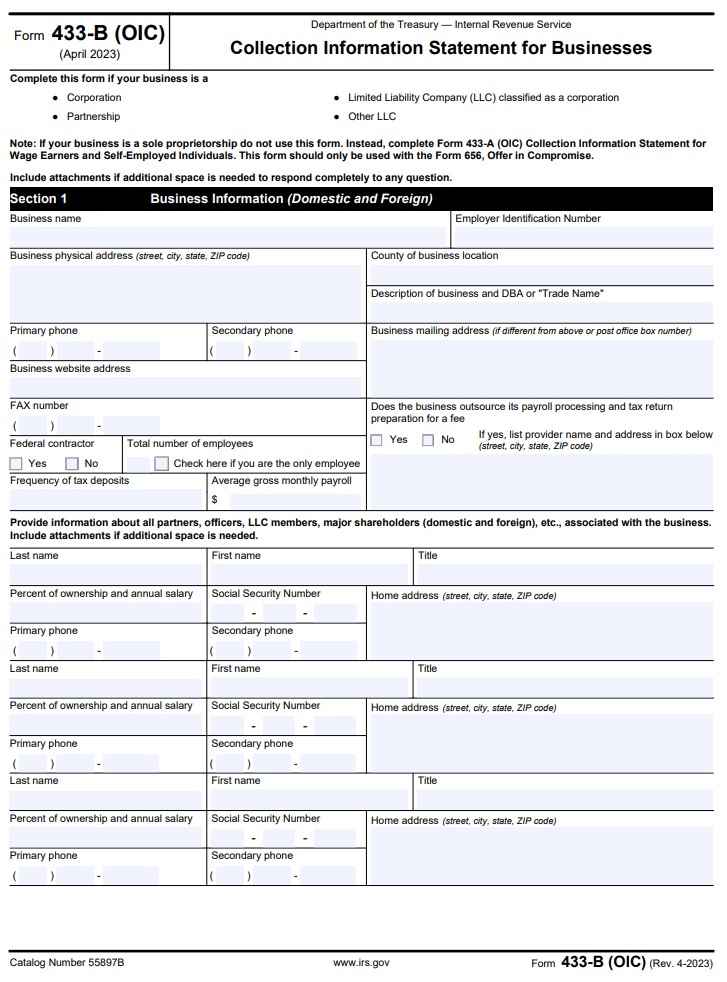
Frequency of Tax Deposits
This refers to deposits for payroll taxes. Businesses should be using an automated payroll service. Our favorite is Gusto since it is simple and completely online. There is no reason to have an accountant still manually doing payroll. We have had a client’s settlement default because his CPA paper filed payroll returns and one was late. This resulted in having to resubmit the settlement.
Percent of Ownership and Annual Salary
The IRS is trying to see what the owners are getting paid. Say the business has a $1,000,000 tax debt and is claiming to be broke, but the owner collects a $500,000 salary and is single. They usually want to see you adjust things down. It’s their view that if the business is suffering a bit financially and cannot keep up on its taxes, then the owners should not be making a ton of money either.
Section 2: Business Asset Information
Here the IRS is looking to see what the business has for assets. Cash, investments, machinery, whatever they deem has some type of value. The key here is quick sale value. Used tools are not worth that much. A vehicle that has mechanical problems or cosmetic issues is worth substantially less than one in good condition.
Cash and Investments
This section goes over basic bank account information to see what cash is in your business bank accounts. Most companies are not going to own stocks or bonds, but fill out this section if any are held by the company.
Notes Receivable / Accounts Receivable
These are simple yes/no questions. The answer for many businesses will be no. Answer yes to notes receivable and you should also attach a list of those notes receivable to your Offer In Compromise. A list is not required for accounts receivable if your business has some when submitting a business Offer In Compromise, but the assigned IRS agent might ask for it later.
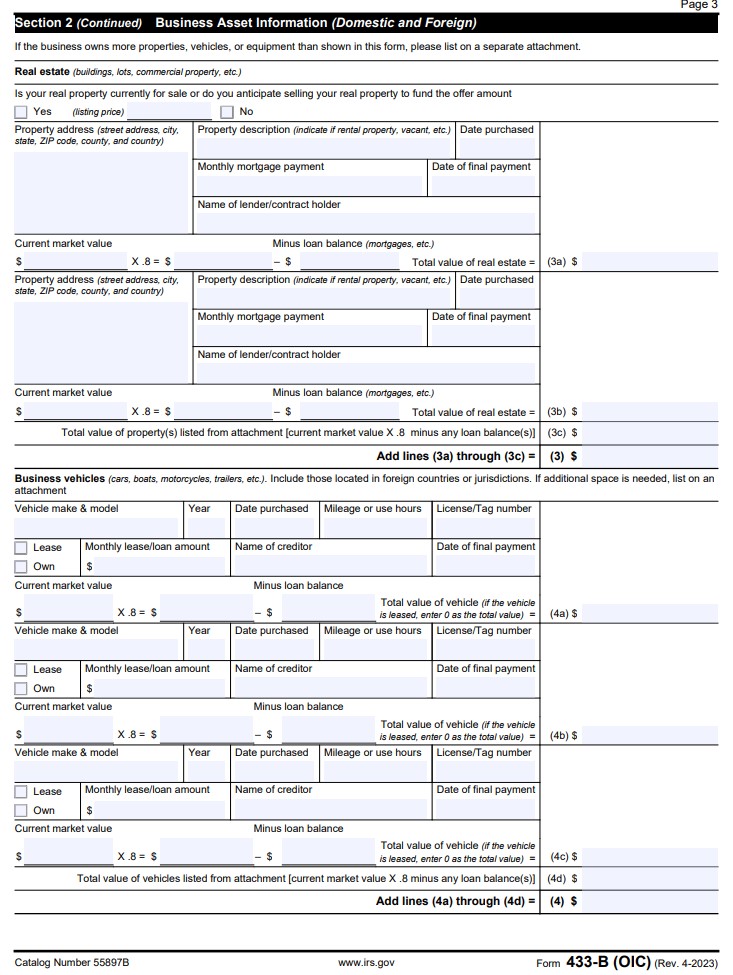
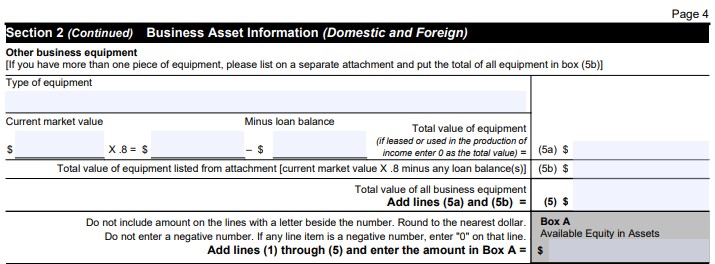
Real Estate – Most Skip This Section
Most businesses do not hold any real estate and should write “N/A” in this section. An Offer In Compromise is extremely unlikely to be accepted if the business owns real estate and the equity is more than the tax amount due. Make sure that if you do include real estate here, you value it with any flaws and defects the property has. Most properties are not perfect, and you want to give an accurate valuation.
Business Vehicles
The same logic applies here. You want to discount the vehicles for any problems and cosmetic issues that they have. Do a comparison on KBB and Edmunds. Pick the lowest one. For purposes of settlement, it is better to lease.
Pro tip: If the IRS later argues that payment is ending so it should not be considered an expense here are the best counter-arguments to get the expense included: If leased: By the time the lease is up and a new vehicle is needed. If purchased: The vehicle will be so old and run down by then, a new vehicle will be needed by the time this payment is up.
Other Business Equipment
These are tools for your trade and related items. Operating equipment should be included here. Again to be clear, quick sale value should be used. Tools that are used are worth much less than new tools in the packaging. The same thing goes for any type of machinery.
Box A – Available Equity in Assets
Box A is everything totaled up related to assets for the business after allowing certain deductions by the IRS. The amount in Box A, if calculated correctly, is what the IRS believes is the reasonable collection value of your business assets. If Box A is more than your tax debt you probably are not getting an Offer in Compromise accepted.
Section 3: Business Income Information
Form 433-B(OIC) gives the IRS how much gross income your business generates on a monthly basis in Section 3. This section is filled out in two ways. One way is if you have a profit and loss statement. Another way if you do not. Enter figures as if they were monthly amounts. For example, if you have a Profit/Loss Statement covering the last 6 months, then divide the number totals by 6.
With Profit/Loss Statement
Many businesses will have a profit/loss statement or can easily make one. In that case, you skip lines 6-10 and fill in the total gross monthly income in Box B.
Without Profit/Loss Statement
If there is no profit/loss statement, fill out the information based on the last 6-12 months. It’s best to put the range of months that produces the lowest average monthly income. Enter the average monthly gross income per category. Most businesses that are filling this out and do not have a profit/loss statement will just be filling out Box 6 and Box B.
Section 4: Business Expense Information
Section 4 of Form 433-B(OIC) determines the total average monthly expenses for your business. The total will then be deducted from Section 3’s total to find the net monthly profit of your business. Filling out this section also differs depending on whether or not you have a profit/loss statement for your business. Enter figures as if they were monthly amounts just like Section 3.
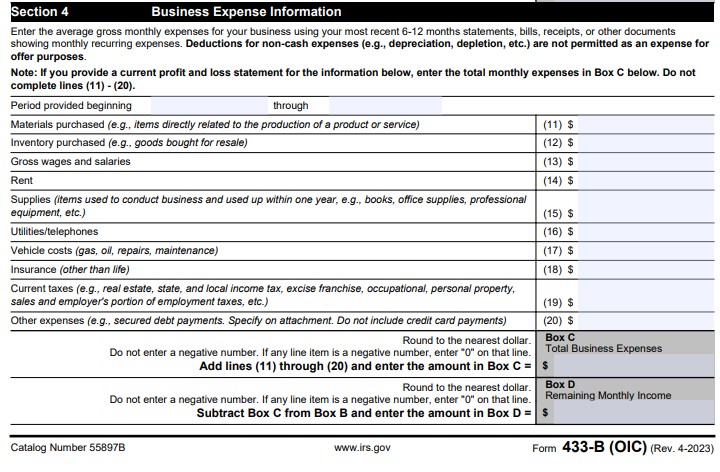
With Profit/Loss Statement
Go straight to Box C with the total expenses from your profit and loss statement figured to a monthly number. Skip lines 11 through 20.
Without Profit/Loss Statement
Fill in categories 11 through 20 based on your actual expenses over the last 6-12 months. Enter the monthly average for each figure. For other expenses, including an attached list of the expenses.
Box D: Monthly Business Profit
Subtract Box C from Box B and enter it into Box D. This is the monthly profit for your business and is used later in your total offer calculation.
Special Considerations On 433-B(OIC) Sections 3 and 4
Here is where our expertise as tax attorneys comes in and these are the things we consider when evaluating cases for Offer in Compromise that apply to these sections you will not hear about from the IRS or an unlicensed ” tax consultant.”
Gross Rental Income, Interest Income, and Dividends
These are Section 3, Lines 7, 8, and 9. The catch with these categories is most businesses that have any of these categories of income often have more assets than the tax balance due. This makes them ineligible for a financials-based Doubt as to Collectibility Offer in Compromise. Doubt as to Liability Offers in Compromise is extremely difficult.
Financials-based is the way to go if your business qualifies. The exception to this is office owners or lessors that are subleasing out some of their offices. That’s still considered rental income but often is not due to an owned asset.
Gross Wages and Salaries
This is Section 4, Line 13 or should be listed on your profit and loss statement if these are paid out. The IRS agent will be looking to see what the officers are getting paid. They want to see that the company’s officers and owners are not making a lot of money and still trying to get an Offer in Compromise.
Example: Doe Corp owes $100,000 in tax debt. John Doe’s salary is $250,000. He is the sole owner and that is still paid consistently. The IRS probably will not grant an Offer in Compromise to Doe Corp. The agent says John should cut his salary to pay the tax due.
Other Expenses
This is Section 4, Line 20. You need to make sense of this section. Do not add expenses that are not business expenses. If it’s something specific to a certain type of business, it is best to explain it in the attachment in addition to listing it. Present everything upfront and clearly. It makes acceptance more likely than keeping the IRS agent guessing what you sent and asking more questions.
Section 5: Calculate Your Minimum Offer Amount
The totals from the Boxes calculated above are used to calculate the minimum offer amount for your business. The amount is supposed to represent the lowest amount the IRS will accept to settle your business tax debts in full.
Page 5 has Section 5 and the first part of Section 6 on it.
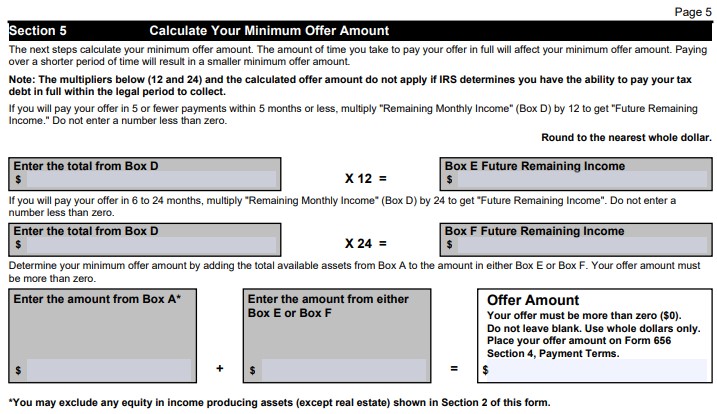
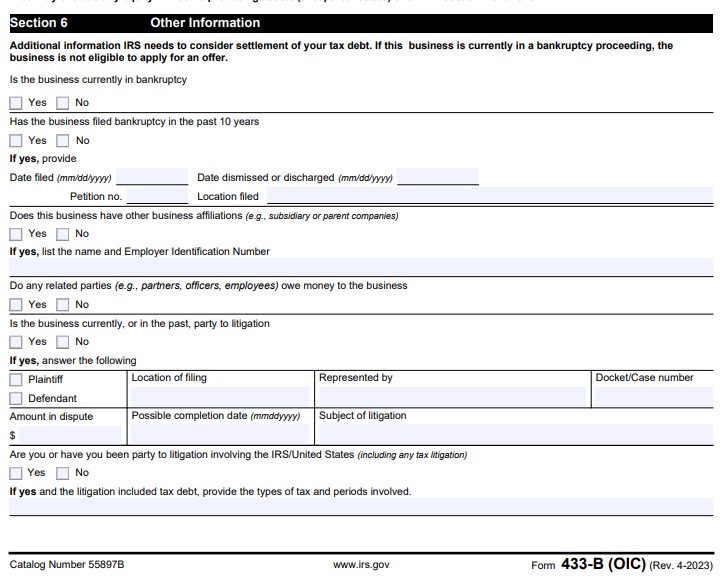
We almost always recommend doing a 5-month payoff Offer in Compromise. The only exception is when your available business income is $0 and there are assets that are being considered in the calculation. You end up paying twice as much to buy the extra time. If you are stuck between these two offers and cannot make payment within 5 months, it is strongly suggested to see who you can borrow from to make it happen, since you save double in the end.
The Actual Offer Calculation and Offer Amount
Paying off within 5 months:
Box A + Box E = Offer Amount
Paying off within 24 months:
Box A + Box F = Offer Amount
Box A is the total available business assets. The total is then added to Box E or F, depending on how long it takes you to pay it off.
The most common reason a 5-month payoff Offer is preferred
A 5-month payoff is the recommended reason in probably 95% of the cases we work on that qualify for an Offer In Compromise, in both business and personal cases. Here are the reasons we prefer a 5-month payoff to a 24-month payoff:
- The overall amount paid to IRS is lower. Half if there is available income.
- IRS liens can be withdrawn faster. Releases also happen faster, but a withdrawal is better.
- Fewer chances for payment to get skipped and mess something up.
- Payments are required while the settlement is pending. This is huge. Debts can be expiring soon. Money paid on debts that were in Offer In Compromise, then rejected, then expired in Currently Not Collectible status, is wasted money.
An example of when a 24-month payoff Offer would make financial sense
John Doe’s business is refurbishing classic cars. The business owns one classic car that still needs work, a 1967 Mustang. It is worth $15,000 and has no loans on it. The available business income is $0 per month. John knows if he fixes up the Mustang he can probably sell it later for much more. John has no way of paying $12,000 within 5 months unless he sells the Mustang. $12,000 is 80% of the value of the vehicle, which the IRS determines is John’s reasonable collection potential. Instead, John goes for a 24-month Offer, and pays the $15,000 over 24 months, in monthly installments of $500.
Pro tip: You can always start with a lower 5-month offer, then later change it to a 24-month Offer when dealing with the IRS agent. This stops you from having to make payments while the Offer is pending, even if you think the 24-month payoff Offer is what you will end up with. Give a reason the assets should not be considered and sometimes it works, sometimes it doesn’t. You then end up with a much lower Offer than the 24-month payoff.
Section 6: Other Information
This section of Form 433-B (OIC) asks general questions about the business and its legal history. The questions are self-explanatory. Litigation that benefits the business or assets sold/transferred for less than full value is what the IRS is looking for.
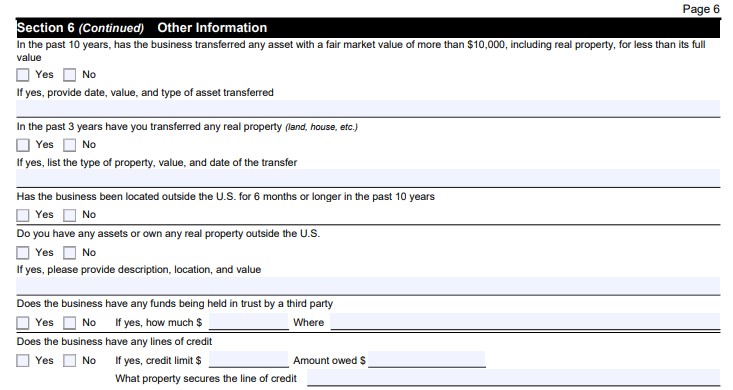
Examples of situations where the IRS may use this information against you
Past Litigation
The business won a lawsuit and received $1,000,000 one year ago. The business tax debt is $500,000 and became owed two years ago. The IRS will weigh this against the business and an Offer in Compromise is less likely.
Pending Litigation
The business is a Plaintiff in litigation for a failed contract and you have good odds of winning the case. The business will get $1,000,000 plus attorneys fees. The tax debt is $250,000. The IRS agent may say we should wait and see what happens, rejecting your Offer in Compromise.
Transferred Assets
Doe Industrials Inc. owned the office of the business in 2017. It was sold in early 2018 before the Offer in Compromise was submitted, but after the taxes were owed, the fair market value of the building at the time of sale was $500,000. The office was sold to the business owner’s mother for $250,000. The IRS may value the building at $400,000, which is 80% of the value at the time of sale. This creates a $150,000 gap the IRS will treat as available in the business’ Offer in Compromise calculation.
Money Owed To Business and Other Funds
The total business tax debt is $250,000. One partner owes the business $400,000. The partner is solvent and has a net worth of $2,000,000. The IRS is less likely to accept an Offer In Compromise here.
Section 7: Signatures
Here the business owner should sign, put their title, and date the document. Make sure to do a wet signature with a real pen. Sign with blue ink. Failure to include signatures will result in a rejection of IRS Form 433-B (OIC) and your settlement.
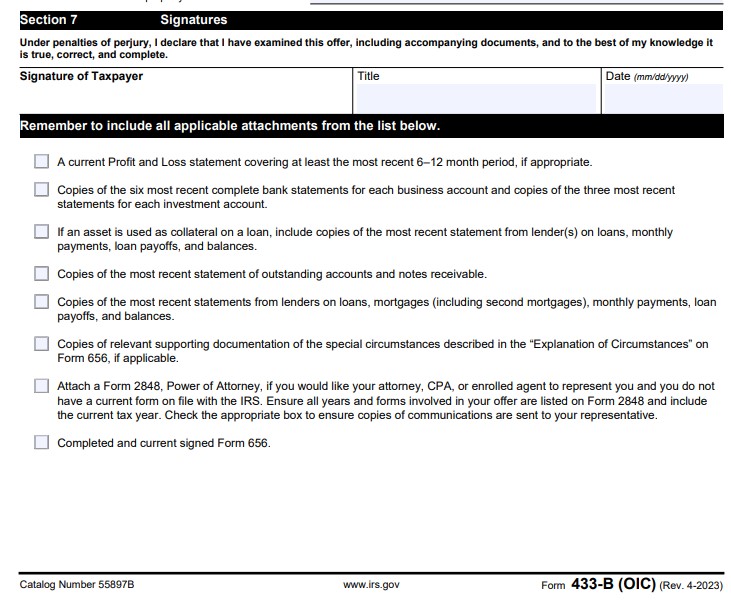
Attachment List for Form 433-B (OIC)
This final part of Form 433-B (OIC) lists the documents you need to include with the settlement package. Form 656 should be in there too, as well as checks for the down payment and processing fee. Send copies of the below information. Below is a pasted version of their list, with my notes in bold:
- A current Profit and Loss statement covering at least the most recent 6–12 month period, if appropriate. You can often use last year’s tax return Profit/Loss statement to get around this requirement if it is not too late in the year.
- Six most recent bank statements for each business account and copies of the three most recent statements for each investment and retirement account. Make sure to send the actual statements that show your business address on them. If your bank account balance had a recent drastic change you want to show that is not in the most recent statement, print out the most recent transactions as well, but still include the last six full statements of all accounts.
- If an asset is used as collateral on a loan, include copies of the most recent statement from lender(s) on loans, monthly payments, loan payoffs, and balances.
- The most recent statement of outstanding notes receivable. Notes receivable is money owed to the business.
- Most recent statements from lenders on loans, mortgages (including second mortgages), monthly payments, loan payoffs, and balances
- Relevant supporting documentation of the special circumstances described in the “Explanation of Circumstances” on Form 656, if applicable. Most will not be filling this part out.
- Attach a Form 2848, Power of Attorney, if you would like your attorney, CPA, or enrolled agent to represent you and you do not have a current form on file with the IRS and it is a red flag if this is being sent with your settlement. Many tax relief firms do not call IRS Collections or put a Power of Attorney on file before doing anything on your case. The Power of Attorney should already be on file if someone is doing this for you. If they are not on file, they probably did not check up on collection statute expiration dates, which is very important, and filing an Offer can be the wrong thing to do in some cases even when it looks like an easy approval.
- Completed and signed Form 656. This is the IRS settlement form.
Final Notes and Suggestions: IRS Form 433-B (OIC)
The IRS wants to see that the business is barely making it by way of Form 433-B (OIC). The officers and owners should not be making a ton of money. Just like they want to see the same thing for an individual Offer in Compromise on Form 433-A (OIC). Many of you reading this guide may also be looking to do an individual Offer and if so see our Personal OIC guide here.
Make Copies and Send Certified Mail With Return Receipt
Make copies of everything you are submitting and save it. My final suggestion is to send all mail correspondence to the IRS by USPS Certified Mail with a Return Receipt. Sometimes, but not often, the IRS loses things you send them. The return receipt is valid proof they got it. Use the proof in case they try to reject your case based on not sending something. However, if they lose the document just send it to them again. Fighting them about them losing it will just cost you more time. Keep copies.
If you do not want to go it alone, schedule a free consultation with one of our expert tax attorneys by submitting a request on our Contact page, or call us at (888) 515-4829 and we’ll be happy to assist.



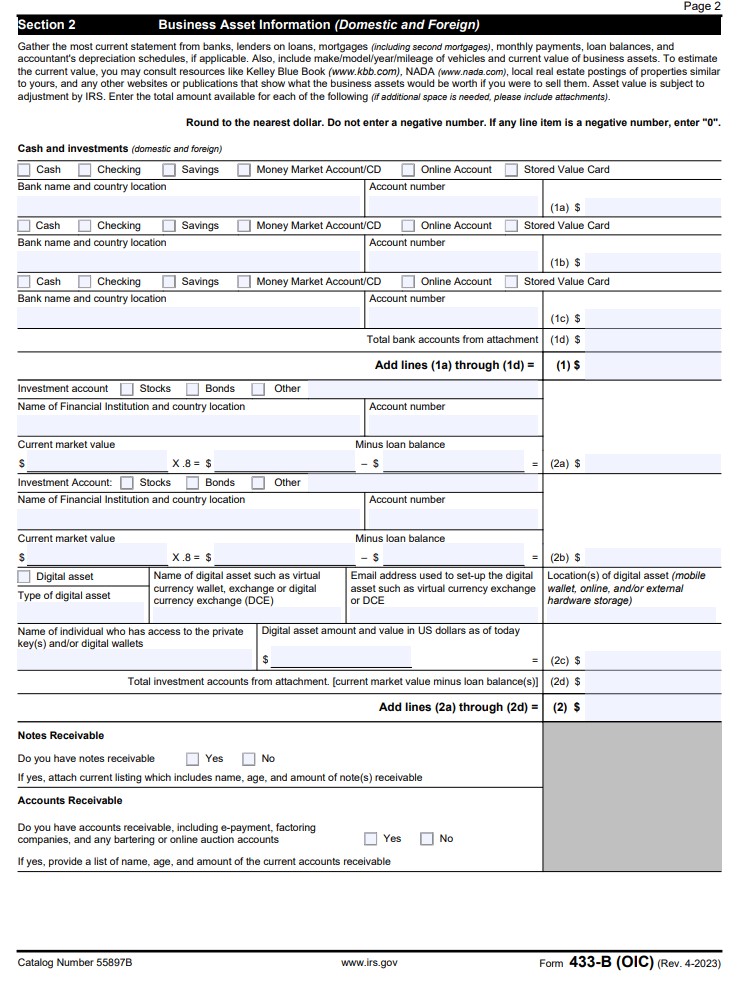
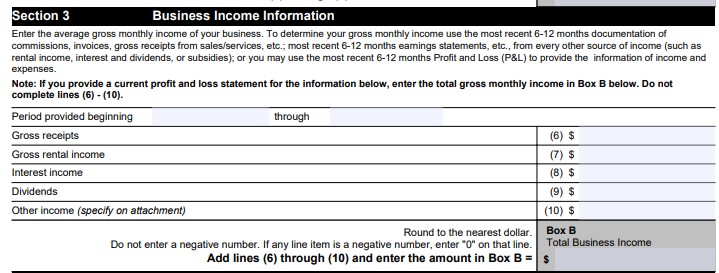
Your article helped me a lot, is there any more related content? Thanks!
Поки / poki это потрясающий сайт, https://ramblermails.com/ полный бесплатных он-лайн игр!
Thank you for your sharing. I am worried that I lack creative ideas. It is your article that makes me full of hope. Thank you. But, I have a question, can you help me?
Рекламное агентство полного цикла «Рекламное Место» оказывает сервиса в сфере медиапланирования и размещения наружной и других видов.
My homepage :: https://vc.ru/u/1044446-alla-viktorova/373593-kak-ispolzovat-segodnya-naruzhnuyu-reklamu
en este publicación consideraremos cómo ordenar los mejores https://medicina-spain.blogspot.com/2025/05/medicina-medicinacom-soluciones.html y cómo clínica dental
ikonic en Terrassa permitirá para que piense en su sonrisa.
в том случае, если у вас
возникла нужда перевезти 2 или 3 авто одновременно, то, в нашем автопарке имеются одноместные и двухместные.
Feel free to surf to my webpage … https://evakuator-ua.com/
El sistema consta de la vibrante paleta de colores digitales de wanabet Preguntas frecuentes, en que
el degradado rosa y “iridiscente” ocupan el lugar
central.
Gente, ?alguien sabe — sin comprobaciones? Estoy jugando aqui: [url=https://20-betcasino-es.com/]aqui[/url]
Las slots pagan bien
Perfecto para Espana
Lithium modulates mir-1906 levels in extracellular vesicles derived from mesenchymal stem cells,
promoting neuroprotection after stroke through regulation of receptor 4, similar to toll https://AutismStemCellFrance.com/.
Do you want to apply this content on own website, or on other digital
platform dedicated to the https://StemCellPriceCheck.com/?
more, although these studies, possible just now opened gates for further research of
stem cells caused by PD, required understand that
potential methods healing with stem cells associated {with relief of the motor symptoms of PD,
and.
My page; https://TherapyStemCellFrance.com
6. Mu J., Bakrin A., Dzhuntunen M., https://StemCellMarketPrice.com/ and others.
Mesenchymal stem cells from Adipose tissue do not improve functional recovery after
ischemic stroke in rats with arterial hypertension.
The submucosa of the small intestine (sis) good It is used in tissue regeneration engineering,
and its unique three-dimensional structure, biological function, and low immunogenicity allow it to be used to repair damaged gastric mucosa (barrile and.
Look into my homepage … https://HealingAutismCells.com
I will be almost always wanting to routinely keep up dated concerning the most current medical information and
facts concerning gestation, for the reason that my function in everyday life is just as a massage during pregnancy therapist.
When assisting this group, I actually realize that there could be very little that any pair of clientele share outside of
the reality that they may be expectant. Yet, pregnancy massage, prenatal
yoga and fitness, and moreover getting a labor and birth doula are typically hints which happen to be virtually globally applicable
to achieve the finest birth and labor journey.
Bonjour, blog creator and readers! I actually have
the ability to claim that I take delight in the Online world.
The increase of the personalized blogging platform, for myself, turned out to
be pretty much the greatest progress at any time! I really like looking at web logs, and this amazing blogging
site is definitely basically no exception. I am employed as an Chair
Party Massage Coordinator. Which in turn simply leaves me personally having a great deal of
down time during the work day to examine personal blogs
and so on. I would personally instead go through web
blogs when compared with media virtually any day. Just what ordinary individuals have to convey,
exactly what these people feel and think, that concerns me
personally so a great deal greater. A blog
is so very private and quite meaningful due to the fact that it
originates as a result of a person’s creativeness and interior expression of themselves.
Naturally, I don’t quite suggest a weblog for a large conglomerate; which definitely not a “web log”
whatsoever!
I really enjoy your providing these details for people wanting to know more on subject areas like this.
Your blog was well written and very well researched, that is certainly very much appreciated.
I actually am definitely searching for unique blogs to consider and read frequently.
Bonjour, blog owner and readers! I definitely can certainly say the fact
I really like the Online reality. The growth of the personalized blog site, for me, was basically nearly the best expansion ever in my life!
I really like scanning blogs, and this kind of blog website is really basically no exception. I am employed as an Chair Massage
For Parties Director. Which fortunately renders me personally having quite a bit of free time at work to peruse web logs and the like.
I would personally instead read blogs and forums compared to media just about any day.
Just what common people today have to say, what they feel and believe, this makes a
difference to me very significantly more. A blogging is
so personalized and really special since it will come from a
person’s ability to create and essential reflection of
their particular own. Keep in mind, I don’t necessarily mean a wordpress blog for a monster conglomerate;
which probably not a “blog” at all!
We may pretty much all benefit from finding out even more about ourselves
and our overall health and fitness. Several actions and movements levels can have superb advantage
to all of us, and all of us need to master even more information about them.
Your blog has presented a invaluable mind-set that is helpful to
a number of groups and individuals, and I actually value the posting your experiences in this manner.
I just can’t believe almost everything we challenge ourselves with in our
lives matters. Continuously put in thinking about the several
things that we experience just about every day is going
to be undoubtedly necessary, as no other woman will probably confront life for any of us.
Personally I think that people ought to be a whole lot more mentally stable.
Knowledge is terrific, however, a lot of whatever we think about is indeed abstract.
Having a cup of tea is a zen activity that takes one back again to the present occasion. We
have to be more in the here and today, without being stressed by our lifestyle and
the drama we encounter every day.
We may all reap the benefits of discover even more regarding ourselves and our overall health and wellbeing.
Specific actions and animation levels can contain great profit to
us, and we all ought to uncover more info about them. Your weblog has furnished worthwhile info that
is helpful to a number of populations and individuals, and I just appreciate the posting your expertise in this manner.
In reality, the large majority of information are more intricate than a amateur
observer might decide on, influenced by their position. I’m not expressing that am a professional on this
unique topic being talked over, and so I believe it’s for different discussion board members to check out.
I am not really striving to make trouble or be irritating.
Instead, I comprehend from working experience that the aforementioned could be the circumstance.
I am properly trained in Postnatal Massage, and in my own selected
occupation, I notice it a great deal. Completely new
Postpartum Massage Therapists are likely to exaggerate promises; which may be, these people don’t at this point genuinely have
an understanding of the limits of their own “scope of practice,” and consequently they may well come up with remarks that are too general when talking
with patients. It’s the identical phenomenon; they have been brought in to a subject, don’t
comprehend the full depth of it, and now assume they are the
Advisors.
That is a great tip especially to those fresh to the blogosphere.
Short but very precise information… Thanks for sharing this one.
A must read post!
I cannot imagine all the things we challenge ourselves with
in our lives matters. On a regular basis invested in thinking about the numerous things
that people face just about every working day is simply undoubtedly necessary,
as no other person will deal with your life for us.
I feel that people should be more grounded. Technology is terrific,
but a lot of what we might know about is indeed abstract.
Having a cup of tea is a zen process that brings one back again to the present few moments.
We need to be more in the here and today, without being overcome by existence
and the crises we encounter each day.
Cabinet IQ
15030 N Tatum Blvd #150, Phoenix,
AZ 85032, United Ѕtates
(480) 424-4866
Cuttingedgedesign
Hi to every , for the reason that I am in fact keen of reading
this weblog’s post to be updated on a regular basis. It carries nice stuff.
My own way of life as a rather busy massage party coordinator does not leave a whole lot of precious time over for contributing my own views on articles and other content, in most cases.
Nevertheless, having visited right now, I wanted to see to it that I began on the best possible footing, and start off with a
comment. It is gladdening in my opinion that there exists an online entry about this key area of interest,
because it’s not spoken about nearly sufficiently in this culture.
People may each and every one reap the benefits of discover
more regarding ourselves and our health and fitness.
Certain activities and exertions levels may include great benefit to all of us,
and we all have to study more info about them.
Your weblog seems to have presented a invaluable mindset that is to be helpful to many different groups and individuals, and
I value your sharing your experiences in this
manner.
This is not really the very first instance I unearthed a
website that was seriously worth participating in a comment
section on. This specific page is advantageous to me. I seriously
live a life of plenty of settings; that is to say that my work functions range the gamut.
I carry out Perinatal Massage. Additionally, I buy and sell collectibles.
I’m getting to know Direct Admin. And, that’s really a
couple of activities I do. In any case, my idea is,
each of us all approaches a niche from a one of a kind perspective.
Just about every encounter all of us have structures us and our own viewpoint of our own selves and the entire world around
us. I imagine identifying some kind of greater awareness of reality is
where every little thing we all communicate regarding brings
us to. That being said, precisely how can folks then interact?
Is it actually possible? I suppose much of our unique contributions
to the Internet Commons shifts many men and women, probably.
Hence think about that, bloggers and folks writing comments.
Your individual feedback can potentially help out another individual.
Or even, responses can easily accomplish the opposite.
Plus, everyone, meaning, you, me, seriously needs to
pay attention to try to benefit other folks to mature and certainly not suffer.
Thank you for this blog; I am submitting this site
together with my various other fine personal blogs I’ve discovered
that I even troubled to opine on. Always keep posting!
Keep articulating!
What’s up, blog creator and readers! I in fact could certainly reveal the fact I enjoy the Web.
The increase of the personalised blogging site, for me, had been virtually the
most excellent improvement actually! I adore browsing weblogs, and this particular blog is certainly basically no exception to this rule.
I work as an Chair Massage For Parties Planner. Which in turn simply leaves me
personally with quite a bit of down time at
work to peruse blogs and such. I’d personally as an alternative
read through blogs and forums as compared with news
just about any day. Just what regular people have to
state, what exactly these people seriously feel and think,
that matters to me personally so significantly
greater. A blogging is so very personal and considerably substantive since it
will come as a result of a individual’s vision and interior manifestation of their particular own. Keep in mind, I never really suggest a site for a enormous commercial
enterprise; which certainly not a “blog” at all!
Grown ups nowadays really need to know more pertaining to some of these topics, though
there seems to under no circumstances quite possibly be sufficient available free time.
Right after available free time for family, and obviously working, precisely what free time
is left over to dedicate to gaining knowledge of all these most vital instructions?
Being an individual utilizing postnatal massage, coupled with producing websites and working with numerous servers, time is without-doubt a thing that I don’t
possess sufficient quantiities of. Ideally, I am capable of finding the hours needed to master this
critical point more specifically. Many thanks for providing
this kind of very helpful learning resource.
This valuable blog website is pleasurable. Article content similar to
this are often brushed aside, if perhaps fact be told. Usually the greatest of the Net is
not really the very most broadly touted content, but instead almost everything else, the disregarded world with weblogs that are truly a lot better than the ones of significant famous men and women. This is this
type of a blog page. I will definitely provide tips, even in cases where we’re
not motivated to do it. First is, continue creating.
Second is, always keep creating routinely. Lastly is, apply your individual blogging
to build up your particular presence. I am possibly not a
author I guess; I am honestly a Postpartum Massage Therapist.
I carry out Postpartum Massage Therapy, serving adult females to recover right after having a
baby. It’s worthwhile work. That is what I expend most of my energy working on, but yet
I have in addition cherished publishing from the moment I was younger.
I am a well-read individual and just about every single year or so I browse a
stack far taller when compared to me personally. hahaha In the upcoming four seasons, maybe I could get determined concerning operating a blog.
The thing is, it cannot simply a notion; the activity of composing
and publishing repeatedly will make a blog site develop in some amount of time.
This is not really the first instance I have discovered a
blog that was actually worth participating in a comment section on. This particular piece of writing is amazing to
me. I definitely live a lifetime of a great
many modes; that is to say that my work functions range the gamut.
I practice Postpartum Massage. Aside from that, I trade in collectibles.
I’m figuring out Centos8. And, that’s merely a couple of activities I
do. In any event, my point is, each of us all considers
a subject matter from a exclusive perspective.
Just about every experience all of us have forms
us and our view of ourselves and the universe all
around you and me. I presume discovering some higher view of real truth is just
where everything we all dialogue about leads to. So, just how do folks in that case
correspond? Is it even possible? I think much of our unique additions to the
Cyberspace Commons changes many people, perhaps.
For that reason consider that, bloggers and commenters.
Your own personal comment might possibly guide a different person. Or, feedback can easily accomplish the antipode.
Not to mention, you in fact have to care to attempt to support others to blossom and not wither.
Thanks a lot for this unique blog; I personally am logging this site together with my various other good websites I’ve found that I actually troubled to opine
on. Always keep penning! Keep articulating!
I am always searching for new info upon this important topic,
and was specifically stoked when I discover sites that happen to be well-written and well-researched.
Thank you for offering this wonderful info, and I take a look onward to reading more from your weblog in the long run.
This valuable blog is stimulating. Content similar to this are as a rule pushed aside, if truth of the matter be provided.
Many times the finest of the World-wide-web
is not the most broadly commercialized subject matter, nonetheless rather all things
else, the forgotten herd with blogs and forums that are literally a long way superior as compared with all those of key celebrated people today.
Now this is such a blog site. I are going to lend advice,
possibly even when ever not encouraged to do so.
First is, maintain writing. Second is, keep penning often. Finally is, utilize your own personal blogging site to improve
your own personal style. I am not even a blog owner I guess; I
am really a Postnatal Massage Practitioner.
I practice Postpartum Massage Therapy, serving females to heal
after having a little one. It’s advantageous work.
That is exactly what I invest the majority of my precious time working
on, yet I have also loved crafting from the moment I was younger.
I am a well-read individual and each calendar year I go through a
collection way higher compared to me personally.
rofl In the upcoming four seasons, probably I could get serious concerning
running a blog. The matter is, it can’t simply just an understanding; the activity of
creating and creation routinely will make a blog site
blossom over time.
What I truly care most about is health topics.
On my own, I subscribe to magazines and catalogs that concerns this subject, and I maintain informed about the most recent wellness research.
Just how is this of any use? Personally I think there is no more crucial use for
my time. Likewise, this blog website seems as though it’s worthy of
my time to check out again. I sift through hundreds
or even more of blogs weekly. Truth be told, my spine usually
hurts and I desire a brand-new spare time interest.
lol Nevertheless, I think if everyone wrote about their niche in the universe, and did it articulately, we’d have a more interesting world.
Ya think more than half folks reviewing this seem to be ladies?
Or sometimes, adult males who take up residence together with a girl?
Which in turn maybe comprises all people. I provide patients with prenatal massage contraindications for
the pregnant people. I appreciate the truth that Therapeutic massage has grown more enormously
regarded like a valid health modality. There’s many scientific tests to
back up this specific technique, unfortunately the community’s
opinion also has a considerable way to go. You will find a number of nasty depictions relating to Massage
practitioners. And yet my own point is, contemplate
precisely how recognized perspectives cause it
to be arduous for mankind to find out that we are professional people?
How many years can it take? Attend to the whole story in all things.
You should never have prejudices based upon deception or simply misrepresented
information.
It’s in fact very complicated in this full of activity life
to listen news on Television, thus I only use web for that reason, and get the latest information.
This is definitely not the first moment in time I have discovered a blogging site that was really worth commenting on. This exact
writing is informative to me personally. I in actual fact live a
life of many ways; that is to say that my employment activities range the gamut.
I perform Postnatal Massage Therapy. Furthermore, I buy and sell collectibles.
I’m figuring out Centos8. And, that’s merely
a few activities I do. Anyways, my point is, each of us approaches a subject matter from a one-of-a-kind mindset.
Just about every experience all of us have structures us and each
of our viewpoint of our own selves and the world around us all.
I think having some kind of elevated impression of reality is where every little thing most of us talk about brings us to.
That being said, how can people afterward relate?
Is it actually possible? I think our own own personal contributions to the Web Commons shifts
a great number of folks, perhaps. So ponder that, bloggers and commenters.
Your feedback can assist some other individual. Or, feedback
can achieve the contrary. And, everyone, meaning, you,
me, in reality should preferably care to attempt to help other people to blossom and certainly
not wither. Thanks a lot for this specific blog site; I am
submitting this post along with my various other good quality weblogs I’ve found that I
actually bothered to comment on. Always keep producing!
Always keep articulating!
What’s up, I read your new stuff regularly. Your humoristic style is
awesome, keep up the good work!
Thanks for sharing. I read many of your blog posts, cool, your blog is very good.
Why people still make use of to read news papers when in this technological globe the
whole thing is available on net?
Your point of view caught my eye and was very interesting. Thanks. I have a question for you.
I always used to read piece of writing in news papers but now as I am a user of net therefore from now I am using net for posts, thanks to web.
Hi, just wanted to mention, I liked this post.
It was practical. Keep on posting!
Americans in these days would be smart to master even more with regards to many of these subjects, even though there seems to in no way be quite enough free time.
Right after time for friends and relations, and needless to say having a job, just what free time is remaining to expend
to understanding these most crucial teachings? Being
an individual employing postnatal massage therapy, in conjunction with conceptualizing websites and administering
a number of computers, time is certainly a commodity i commonly do not
have a lot of. With any luck, I am able to find the time necessary to
go through this most important topic more thoroughly.
Thanks to you for passing along this unique superior reference or resource.
#file[Blog_Comment.dat
Solely came across this article – https://www.cornbreadhemp.com/pages/what-s-the-recommended-dosage-for-cannabis-gummies and it explained all things de facto clearly. I had a lot of questions nigh CBD gummies and this needy it down in a motion that in reality makes sense. Wonderful utilitarian to when all is said read something that’s affable to accept without all the confusing jargon.
Большой русско-испанский словарь 250 000 выражений
и их сочетаний (офсет) https://spainslov.ru/site/word/word/%D0%93%D0%A0%D0%AB%D0%96%D0%90 Словарь Автор: Сост.
This is not really the very first time I discovered a blog website that was truly worth commenting
on. This particular kind of page is high quality to me personally.
I honestly live a daily life of a great number of settings; that is to say that my employment routines range the gamut.
I perform Perinatal Massage Therapy. On top of that, I trade in collectibles.
I’m mastering Linux. And, that’s really a couple of
pursuits I undertake. In any case, my idea is, each one
of us all approaches a niche from a unique standpoint.
Virtually every experience all of us have forms us and our own view of ourselves and
the environment all around us. I ponder getting hold of some more significant view of real truth is exactly where everything many
of us chat about leads to. So, just how will people young and old then communicate?
Is it actually possible? I believe our own individual contributions to the Cyberspace
Commons transforms quite a few men and women, most likely.
Therefore contemplate that, blog authors and everyone writing comments.
Your comment can certainly support some other individual.
Or perhaps, comments can easily achieve the opposite.
And, you actually should preferably pay attention to try to aid others
to mature and definitely not wither. Thanks for this blog; I am logging this post together with my additional incredibly good blogs
I’ve found that I perhaps even troubled to opine on. Keep crafting!
Continue to keep articulating!
Your site has surely supplied me with just the information that I just needed.
We currently have been doing analysis on this matter for quite
a while, and this seems to have taken a very long while to find a blog that provides all of the facts i
want. We take a look toward examining more websites written by you in the
foreseeable future, and am going to research here 1st the very next time I
just have got another research project.
The Trezor Model T is a premium class hardware wallet created for storing several cryptocurrencies, including Bitcoin, Ethereum, https://cosmos-wallet.io// and Litecoin.
This is absolutely not the first time I came upon a blog site that was well worth
commenting on. This unique information is interesting to me personally.
I in actual fact live a lifetime of a great many
ways; that is to say that my work routines range the gamut.
I carry out Perinatal Massage. Also, I trade in antiques.
I’m figuring out Linux. And, that’s basically a couple of pursuits I undertake.
Anyways, my idea is, each of us all considers a subject from a unique view.
Nearly every situation all of us have patterns us
and our own view of ourselves and the universe all around us all.
I believe that discovering some kind of higher sense of actuality is exactly where almost everything all of us communicate about leads to.
That being said, precisely how do individuals then interact?
Is it actually possible? I suppose much of our personal additions to the Cyberspace Commons alters a good number of people,
sometimes. Thus think about that, blog freelance writers and
people leaving comments. Your own personal comment can certainly guide a different person. Or even,
responses can accomplish the contrary. Plus, you really need to care to try
to guide others to improve and not wither. Thanks
for this specific weblog; I personally am filing this blog along with my other great websites I’ve uncovered that I perhaps even bothered
to opine on. Always keep publishing! Always keep expressing!
Thanks for sharing. I read many of your blog posts, cool, your blog is very good.
I just appreciate your providing this info for individuals hoping
to get more info about issues like this. Your
blog was well-written and very well researched, that is certainly significantly
treasured. I actually am at all times looking for new
websites to follow and browse regularly.
I just tried Fiverr’s SEO VIP Solution and the results are outstanding!
Highly recommend for anyone who wants better rankings.
Right here is the right web site for everyone who would like
to find out about this topic. You understand so much its almost tough to argue with you (not that
I really will need to…HaHa). You definitely
put a fresh spin on a subject which has been discussed for ages.
Great stuff, just great!
Đối với người chơi mới, nơi đây mang đến chương trình khuyến mãi nạp tiền lần đầu cực kỳ hấp dẫn. game 66b Khi làm thao tác này thì hội viên sẽ nhận được một khoản thưởng tương ứng với tỷ lệ phần trăm trên số tiền nạp, thường từ 50% đến 100%. TONY12-10A